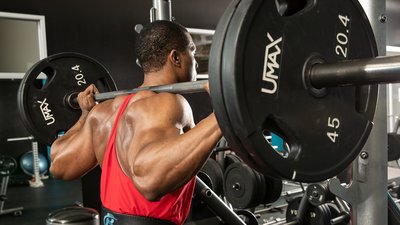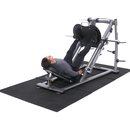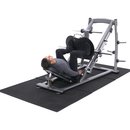Given that you're on Bodybuilding.com, you aren't interested in getting big or strong; you want to get big and strong! As a beginner, you can tackle both goals simultaneously with most basic barbell programs. As you gain experience and specialize your training, however, one of those goals will typically flag. The answer isn't to use separate programs that sacrifice one capacity for improvement in the other, but to use a smart program designed to improve both goals.
I've got just the thing. It's a painfully simple idea: Load up one week and lift big weight, and then get your high-volume pump on the next week to add size. Alternate heavy, intense lifting with high-volume training to build muscle and strength. By switching your focus week to week, you can control your program and obtain dual gains.
Before we dive into the details, I've got two caveats:
Mind Your Nerves
Your central nervous system (CNS) can fatigue rapidly, especially when exposed to heavy lifting. Athletes may be more conditioned to it due to the rigors of their training, but recreational lifters might not fare as well. It's good to limit heavy lifting days and numbers, but heavy "grinder" sets have their place and should appear in every strength-and-size program.
Cumulative Volume Counts
Cumulative volume refers to the workout volume on a particular day and during the course of a week. If you want your upper back to grow, how many horizontal pull variations are you doing weekly, not just daily? This will be crucial for size.
For strength, it's important to focus on quality for max lifts. It doesn't make sense to train to failure when the point is to stimulate the nervous system and recruit more muscle. We don't want to kill our nerves and have flat output!
The Program Design
I like to alternate a CNS, heavy-lifting week with a high-volume, high-rep week. An eight-week program of this nature will supercharge strength-and-size gains. As for the benefits:
- Most size-based programs ditch big lifts for isolation exercises. This can kill your max strength and lower absolute strength for more cosmetic size. On my program, you still get to work with heavy barbell exercises every other week!
- The neurotransmitters and CNS get fried during most heavy strength training, which makes recovery important. It could take several days for your body to return to normal depending on how much heavy loading you do. A high-volume week between heavy weeks is the easiest way for the CNS to recover. Focus on size when you're not focused on strength!
- You get a measure of fat loss benefits when you couple the hormone release of strength training with the low-rest interval of size training. Burn fat, build muscle, and boost strength? Perfect!
A Little Taste
This is a general idea of what my program looks like week to week. Follow the ideas to help you build your own killer workouts for strength and size.
- Day 1: Back
- Day 2: Chest
- Day 3: Legs
- Day 4: Shoulders
- Day 5: Arms (optional)
Week 1: CNS Loading
Choose a major barbell movement for a given muscle group. For example, if you choose back, pick something like the trap bar deadlift, deadlift, or Pendlay row. Perform "ramping sets" by starting with a relatively light weight and going heavier on each set until you reach your "working sets." Go with 5 sets of 5 reps or 8 sets of 3 reps.
Finish your final working set with a "burnout set" at 60 percent of your heaviest load for as many reps as possible. The goal is to encourage more hormone release. Then choose 2-3 large movements like T-bar rows, seated rows, pull-ups, inverted rows, or single-arm dumbbell rows, and perform 4 sets of 8-12 reps for each.
Week 2: High-Volume
Choose the same barbell movement for the given muscle group and employ a high-volume training method. This can involve anything from a simple protocol of 5 working sets of 10-12 reps to advanced lifting methods that increase time under tension, employ rest-pause sets, or involve strip sets.
Your leg day, for example, could follow German volume training for 10 sets of 10 reps, or you could try one of my personal favorites, ladder sets. Ladder sets involve multiple rep schemes with short intra-set rest periods. Watch them kill me in the video below.
Squat Ladder Set
Use five working ladder sets and limit your rest intervals to no more than two minutes between sets. This will be the primary movement for your workout.
Now, like the CNS week, choose 4 more exercises to perform as 2 supersets and perform a minimum of 12 reps per exercise. Keeping with the leg day example, two high-rep superset exercises could be:

BodyFit
$6.99/month- 2,500+ expert-created single workouts
- 3,500+ how-to exercise videos
- Detailed workout instruction
- Step-by-step workout tips
- Training at gym or at home
- Access to Workout Plans
- Access to Bodyfit App
- Store Discounts
Already have a Bodybuilding.com account with BodyFit? Sign In

What comes with BodyFit?

- Instructional Videos
Don't risk doing a workout improperly! Avoid injury and keep your form in check with in-depth instructional videos.

- How-to Images
View our enormous library of workout photos and see exactly how each exercise should be done before you give it a shot.

- Step-by-Step Instructions
Quickly read through our step-by-step directions to ensure you're doing each workout correctly the first time, every time.
Other good exercises include rear-leg elevated split squats, leg extensions, or deficit reverse lunges.
Deficit Reverse Lunges
The above ideas should show you how to structure the overall system. It's important to note that this program structure won't render the absolute greatest results for strength or size, but it will ensure that you don't lose your capacity for either. It will help you get and stay big, and allow you to keep heavy lifts in your routine. If you want to kill two birds with one stone, this is a sure-fire way to blast your muscles for maximum strength and size!




